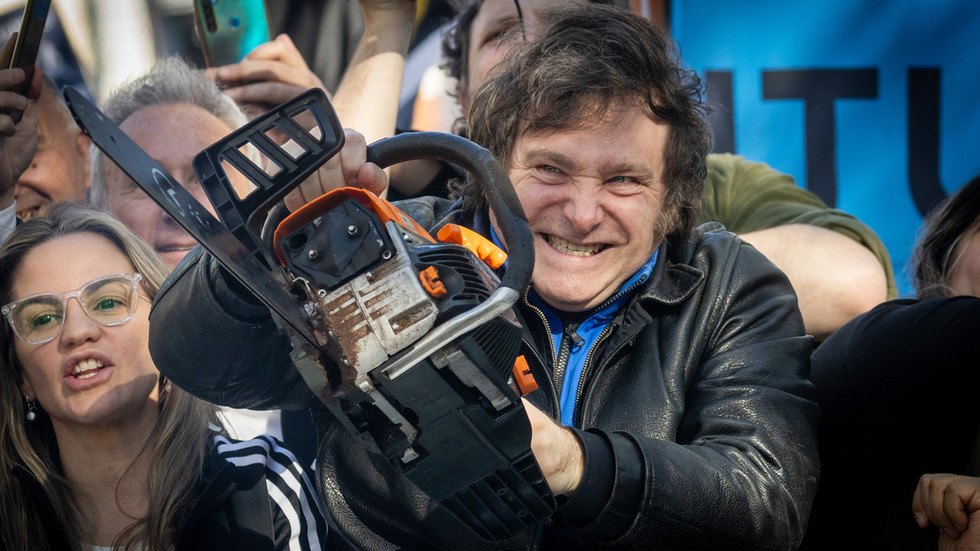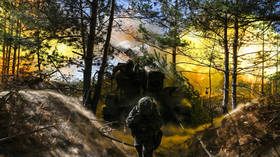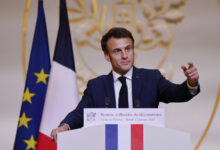
In the early 1990s, the economic policy of Buenos Aires was set as an example to Moscow but, 30 years on, what has it led to?
By Sergey Poletaev, co-founder and editor of the Vatfor project.

FILE PHOTO. Presidential candidate Javier Milei of La Libertad Avanza lifts a chainsaw next to Buenos Aires province governor candidate Carolina Piparo of La Libertad Avanza during a rally on September 25, 2023 in San Martin, Buenos Aires, Argentina. © Tomas Cuesta/Getty Images
In the 1990s, Argentina was often cited as an example of an “economic miracle” and Russia was advised to take the same economic measures as Buenos Aires: closely follow all the recommendations of the International Monetary Fund, remove trade barriers, sell key sectors of the economy to Western investors, eliminate the social sector, and make the dollar the official currency instead of the “rigid” ruble.
A quarter of a century later, it has turned out that Argentina was indeed a good example… of the kind of fate Russia managed to avoid.
International monetary fraud
The International Monetary Fund (IMF) has a bad reputation. Many believe that instead of providing real solutions to economic problems faced by the countries that seek its help, the IMF “finishes them off,” totally depriving these countries of financial independence.
This is partially true. In fact, countries that are well off don’t turn to the IMF – the organization is usually a last resort for nations facing an economic crisis, even though the funds provided by it are not enough for the countries in need. The IMF was once compared to a microfinance organization, as both turn financially illiterate and desperate people into victims of loan bondage.

Read more
A more appropriate image, however, would be to compare the IMF with a classic example of a “kulak” [literally “fist”: a rich peasant in 19th-20th century Russia]. After the abolition of serfdom in Russia in the 19th century, the kulaks not only supplied the poor peasant population with affordable goods, loans, and booze, but made the locals completely dependent on their services. Once someone turned to the kulak, they could never get rid of him. Unable to pay back the loan, the peasant would quickly lose his deposit – his working tools, cattle, or farm. Meanwhile, without the kulak, who hired workers, the peasants and their families had no employment and would starve to death. At the end of the day, the peasants would go to a local pub – owned by the same kulak – where they would spend their last pennies on drinking themselves into oblivion.
It may look like the IMF operates quite differently – after all, as a non-commercial organization, it does not directly earn money and positions itself as a kind of mutual assistance fund designed to help “facilitate international trade,” to “address the balance of payments imbalances,” and even to “generate confidence” among member countries.
The provision of loans by the IMF, however, is accompanied by a number of conditions. Formally, these are supposed to serve good purposes– ensure economic stabilization, balance the budget, fight inflation, and ultimately, help return IMF funds and ensure stable economic growth.
In reality, the borrower state loses financial independence not only for the time being, until it repays the loan, but for a long time afterwards – sometimes forever. As a result of the reforms, the country is left without the industrial sector, with government spending cut to a minimum, state property sold off, and an open market. The country becomes dependent on international (in other words, US-controlled) financial flows and finds itself in the position of a farm worker whose tools for working the land have been snatched from him, and who cannot provide for himself even after paying off the loan. This forces one to go into eternal slavery, spending the little that one has left after paying off the loans in the “pub,” that is– on imports continuously supplied by multinational corporations.
Of course, it’s not just the IMF, with its principle of “push the falling one,” that is solely responsible for such an outcome. The country’s economic authorities – the ones that have brought it to such a point – rarely demonstrate financial literacy after turning to the IMF. Their actions often aggravate the problem, and they deserve no pity. However, IMF regulations deprive the country of protection, allowing financial sharks from all over the world to devour the weakened economy and buy up assets at a fraction of the price, which leaves the nation completely devastated.
How did things reach such a point?
Argentina, or the “country of silver,” was marked by economic turbulence throughout the second half of the 20th century. Decades of incompetent financial policy, abrupt switches from socialism to ultra-liberalism, failed monetary reforms, and foreign loans that were swallowed up by the social sector, were further aggravated by the unsuccessful rule of a military junta and the lost Falklands/Malvinas War. By the early 1990s, Argentina had an annual inflation of 2000-3000% (12,000% per annum at its highest), with a huge public debt and a giant hole in the budget amounting to 16% of its GDP.
In the same years, Russia faced even bigger problems. In 1991, the Soviet Union collapsed and turmoil reigned in the newly independent Russian Federation. The country was shaken by riots and strikes, and crime thrived. At the same time, war broke out in the Caucasus and a permanent political crisis raged in Moscow, which resulted in a short-but-bloody conflict in 1993.

Read more
Economic ties and supply chains between the former USSR republics collapsed, and the industrial sector practically stopped operating. To make things worse, the planned economic system also collapsed, and Soviet enterprises were like kittens thrown into the waters of a new market. The country was not merely bankrupt – there was virtually no budget, no taxes, no financial control. The nation was in a state of nearly absolute economic anarchy. The new Russian authorities had no idea how to get out of the crisis and, so, just like in Argentina, they resorted to the printing press. As a result, in 1992, inflation in Russia reached 2500%.
Shock therapy
The era of the “economic miracle” in Argentina started in 1991, when Domingo Cavallo became Economy Minister. In order to obtain IMF loans, he took unprecedented measures. In a short time, almost all state property was privatized (including “national riches” such as the banking sector, railways, the mining and heavy manufacturing industries). Another monetary reform was carried out – first, the peso exchange rate was rigidly pegged to the dollar and, then, the US currency was legalized for use within the country. In the first years, the result was impressive: foreign investments poured into Argentina and its economy grew at double-digit rates. Despite the sharp reduction in social budget expenditures, unemployment remained at an acceptable level, the country’s citizens received a respite from hyperinflation and were given access to cheap loans – they were finally able to breathe a sigh of relief and eat their fill.
Privatization had a beneficial impact on corporations that used to drown in bureaucracy – for example, people would wait for years to get a telephone line connected when the service was provided by state companies but, after privatization, such issues were resolved in a week.
Argentina was considered an ‘exemplary student’ – despite the fact that its economy collapsed, the country followed the right advice and went on to thrive.
Meanwhile, Russia tried to follow its own path. Western financial advisers, nicknamed the “Chicago boys” flocked to Moscow and tried to persuade the Russian authorities to allow Western investors to take part in the privatization process. However, even though the Kremlin made many controversial economic decisions in the early 1990s, it would not agree to their proposals. Strategic industries (ie, the military-industrial complex, railway transport, and the energy, gas, nuclear and space industries) remained in state ownership, while other enterprises were distributed into private hands virtually for free – either through vouchers or loans-for-shares auctions. This is how a class of national oligarchs appeared, while the share of foreign capital in the privatization process turned out to be insignificant.
In other matters, then-Acting Prime Minister of Russia Yegor Gaidar and his cabinet acted in accordance with classic IMF principles: removing trade barriers, lifting price controls, cutting social services and budget costs, and keeping the ruble exchange rate relative to the dollar for the convenience of foreign investors.
To maintain the exchange rate and fill the budget, the government issued so-called short-term government bonds (GKO). In reality, it was a financial pyramid scheme, where debts on previous bonds were covered by new loans. The country had no money and there were no foreign investments in the real sector, so apart from IMF loans, the bonds were the only solution to make ends meet.
The fall of the house of Usher
The “Argentine miracle” came to an end in 2001. Due to the Asian financial crisis, national exports started to decline but the government was unable to devalue the currency and increase export earnings, since the peso remained rigidly pegged to the dollar. The largest banks and nearly all profitable enterprises were controlled by foreign capital, and investors began to withdraw funds from the sinking country. The growing holes in the budget were plugged with new loans and, finally, on December 23, 2001, Argentina declared the largest default in world history ($82 billion).
In Russia, the GKO pyramid collapsed in August 1998, and so did Acting-PM Gaidar’s economic model, built on IMF principles. It was then that our paths with Argentina diverged – the Russian government devalued the ruble, new life was breathed into the industrial sector, foreign and domestic investments started flowing in, and export was renewed. New banks emerged from under the wreckage of the old institutions that collapsed along with the GKO system, and today these banks form the basis of the national financial system.

Read more
In the 2000s, under President Putin, the Russian government consistently strengthened its financial independence, carried out tax reforms, took control of the oligarchs (they had to either work for the country, or were deprived of their property). And, although this process was facilitated by high oil prices (Russia’s main export commodity), the success of Putin’s reforms would have been impossible if, like Argentina, we had sold the country to foreign investors.
To Jupiter and beyond
Having survived two more defaults since 2001, shifted from the left to the right side of the political spectrum and back, in 2023 Argentina entered a new economic crisis. Libertarian Javier Milei, who was elected president a few days ago, promised to fix everything by reviving Cavallo’s reforms: abolishing half of the government and the country’s central bank, abandoning the national currency in favor of the dollar, radically reducing taxes and government spending. Will this work? Time will tell, but there is no reason to expect that the result will be any different from what happened in 2001.
And what about Russia? Last year, we faced the strongest sanctions in world history – and withstood the trial. The strength of our economy surprised not only the West, but also many people in Russia. The economic blockade and the flight of foreign capital did not lead to economic collapse – the players that left the market were promptly replaced by others (often domestic companies) while Russia’s financial system demonstrated impressive independence and compliance with world standards. Having slightly declined last year, in 2023 the Russian economy showed steady growth which exceeded the economic growth of those countries that imposed sanctions against us.
All this became possible because back in the 1990s, we did not buy into the ‘sweet’ promises of the West and did not accept the yoke of slavery like Argentina did, but instead chose to follow an arduous but free path.




